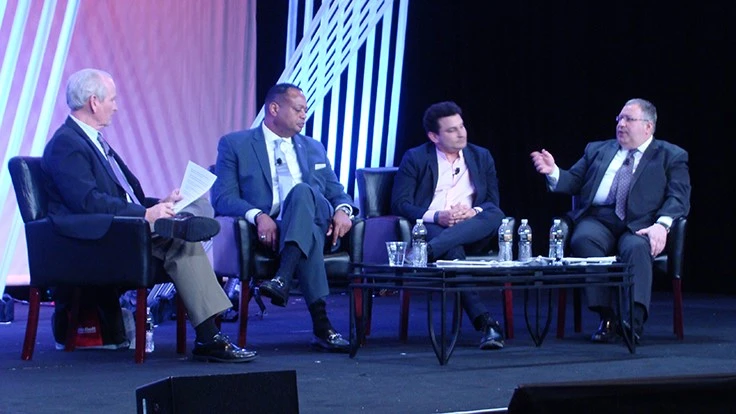
Pictured above, from left: moderator Greg Dixon of SMART Recycling Mgmt.; panelists Philip Bell of the Steel Manufacturers Association; Sean Davidson of Argus Media; and Nathan Fruchter of Idoru Trading Corp.
The steelmaking sector in the United States is among the global leaders in its use of scrap-fed electric arc furnace (EAF) technology, with about two-thirds of its steel made via EAFs. However, a speaker at the Ferrous Spotlight session at the ISRI2018 convention, held in Las Vegas in mid-April, indicated issues with the metallurgical chemistry of scrap are causing steelmakers to increasingly turn to iron-based metallics such as direct-reduced iron (DRI) and hot briquetted iron (HBI).
Philip Bell of the Washington-based Steel Manufacturers Association (SMA) noted steelmakers in the U.S. used 40 percent scrap as feedstock in 2008, a figure that has grown to just 43 percent in 2017 despite growth in EAF market share and despite steelmakers having access to a significant national ferrous scrap surplus. The share of iron-based metallics such as pig iron, HBI and DRI, meanwhile, has grown in that same time frame from 27 percent to 33 percent. (The market share loser has been the hot metal that feeds integrated steelworks, falling from 33 percent to 24 percent.)
“Scrap is going to continue to be the primary raw material for EAFs,” stated Bell, but he said that since its “chemistry can be variable,” some steelmakers are investing in DRI and HBI alternatives. Bell pointed to the chemistry of No. 2 heavy melting steel (HMS) bundles as having declined in recent years. And despite the quality efforts of shredding plant operators, the fact that “obsolete scrap is growing as a percentage of overall scrap” negatively affects the overall chemistry quality of ferrous scrap.
Despite this gray cloud, Bell pointed out that additional EAF capacity coming online in the U.S. in 2018 and the following years will likely help maintain strong demand for ferrous scrap in the domestic market. Globally, the EAF market share of 24.3 percent is likely to rise, said Bell, with basic oxygen furnace (BOF) capacity in China being slowly replaced by EAF production.
Nathan Fruchter of Lawrence, New York-based Idoru Trading Corp. advised ferrous scrap shippers to beware of contract language that covers buyers in the case of shipping disruptions but that may leave sellers holding the bag when a delayed shipment occurs.
He advised ferrous scrap exporters “to include certain clauses in your contacts” that “protect against shipping changes one cannot control.” He also urged them to get a letter of confirmation from the shipping line when making an initial arrangement.
Fruchter also provided Ferrous Spotlight attendees with several reasons (and examples) why they should consider hedging some of their transactions via futures contracts now available from Nasdaq, the Chicago Mercantile Exchange (CME) and the London Metal Exchange (LME).
Recyclers, said Fruchter, are open to risk from price movements “with product building in inventory during a 30-day period.” He also remarked that while steel mills “can stop buying scrap for weeks,” recyclers cannot turn away too much supply, and thus also would benefit on that front by hedging some of their risk.
Houston-based Sean Davidson of Argus Media provided an overview of recent ferrous scrap and steel pricing, and noted the spread between the price of scrap and the cost of finished steel has been wider than normal much of the past 12 months.
Davidson commented, “It’s been incredibly hard to ship scrap” in late 2017 and early 2018, with problems in the trucking, rail and barge sectors occurring simultaneously.
Bell of the SMA chimed in regarding the railroads, “Dealing with Class I railroads is like being forced to give a bad waiter a big tip.”
Davidson also posited that the actual number of vehicles totaled and shredded because of Hurricane Harvey may have fallen well short of initial estimates in the 1 million range. However, he added, even if 250,000 vehicles have been shredded, that equates to about 280,000 tons of ferrous shred on the market and some 1.3 million pounds (650 tons) of nonferrous zorba produced in the Southeast. Hurricane Harvey-related demolition scrap continues to hit the market, he added.
ISRI2018 was April 14-19 at the Mandalay Bay Resort & Casino in Las Vegas.
Latest from Recycling Today
- BMW Group, Encory launch 'direct recycling’ of batteries
- Loom Carbon, RTI International partner to scale textile recycling technology
- Goodwill Industries of West Michigan, American Glass Mosaics partner to divert glass from landfill
- CARI forms federal advocacy partnership
- Monthly packaging papers shipments down in November
- STEEL Act aims to enhance trade enforcement to prevent dumping of steel in the US
- San Francisco schools introduce compostable lunch trays
- Aduro graduates from Shell GameChanger program





